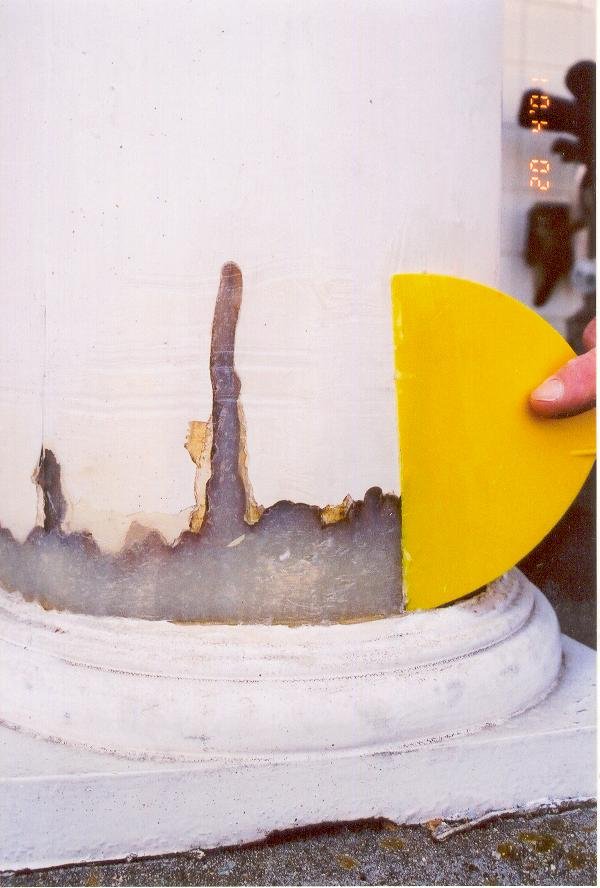Measuring the Performance of Wood Repair Epoxies: 5 Key Criteria
Measuring the Performance of Wood Repair Epoxies: 5 Key Criteria
Wood repair epoxies are vital tools in preserving and restoring historic and modern wooden structures. They are used to fill voids, rebuild damaged sections, and stabilize deteriorated areas without compromising the structural or aesthetic integrity of the wood. However, not all wood repair epoxies are created equal, and their performance must be carefully evaluated to ensure their long-term effectiveness. Below are five key ways the performance of wood repair epoxies can be measured.
Column Repair with Epoxy
1. Adhesive Strength
The adhesive quality of an epoxy is critical for bonding with the wood substrate. A high-performing wood epoxy must penetrate and adhere well to sound wood fibers to ensure a strong, lasting repair. Adhesive strength is typically tested by applying the epoxy to a wooden surface and subjecting it to tensile or shear stress. Epoxies with superior adhesion maintain their bond under load, even in challenging conditions such as fluctuating humidity or temperature. Poor adhesion can result in separation or failure, compromising the repair.
2. Compressive Strength
Compressive strength measures the ability of the epoxy to withstand loads and resist deformation when pressure is applied. In structural repairs, this property is crucial because the wood repair epoxy must bear weight or external forces, much like the original wood it replaces. Testing compressive strength involves subjecting cured epoxy samples to increasing force until they fail. Epoxies designed for structural repairs should exhibit compressive strength comparable to, or exceeding, that of the original wood.
Cohesive Failure
Conventional wood epoxies lack the strength and flexibility to move with the natural expansion and contraction of wood.
3. Durability in Environmental Conditions
Wood repairs are often exposed to varying environmental conditions, including temperature fluctuations, moisture, and UV radiation. A good wood repair epoxy should maintain its performance and resist degradation under these conditions. Laboratory tests can simulate accelerated aging, exposing samples to extreme temperatures, humidity, and UV light. The epoxy’s resistance to cracking, delamination, or discoloration over time indicates its long-term reliability. Durability is particularly important in outdoor applications, where environmental stresses are more pronounced.
Testing
A critical step in developing a wood repair epoxy is lab testing to establish a baseline performance criteria.
4. Workability and Curing Time
The practical application of epoxy is another critical performance factor. Workability refers to how easy the material is to mix, apply, and shape. Factors such as viscosity, pot life (the time before the epoxy starts to harden), and sanding properties play a significant role in determining whether the epoxy can be used efficiently, especially in intricate repairs. Additionally, curing time impacts the project timeline and usability. High-performance epoxies strike a balance between sufficient working time and rapid curing, ensuring efficiency without compromising quality.
5. Compatibility with Wood
Epoxy’s compatibility with wood is essential for maintaining the material’s aesthetic and structural integrity. This includes its ability to penetrate wood fibers and bond effectively without causing damage to surrounding areas. A high-quality epoxy should mimic the flexibility and expansion properties of wood, preventing stresses that could lead to cracking or separation as the wood expands or contracts. Compatibility testing can involve assessing shrinkage during curing and the epoxy’s ability to integrate with the wood’s natural fibers.
Strength & Flexibility
Conclusion
The performance of wood repair epoxies can be evaluated through measuring adhesive, cohesive, and compression strength. Environmental durability, workability, and compatibility with wood must also be considered.
By prioritizing these criteria, conservationists, contractors, and DIY enthusiasts can ensure effective, durable repairs that restore both the function and appearance of wooden structures. Testing and selecting the right epoxy for each project are crucial steps in achieving lasting results and preserving the integrity of wood-based architectural elements and furniture.
Dura-Fix Wood Repair Epoxy is engineered to provide a high degree of adhesive and compression strength ( ASTM D-790 and ASTM D-695 ). Dura-Fix exhibits exceptional modeling and tooling properties.
More information is available at www.nxtgensys.com/products
John Stahl
Next Generation Systems
Mobile: 607-760-6658




